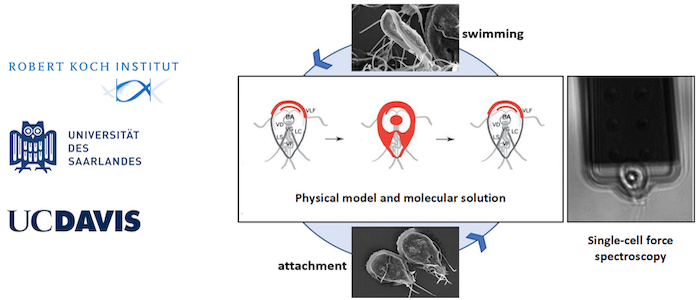P1 - Physics of Giardia adhesion
The physics of adhesion of Giardia duodenalis and its structural basis: Understanding the key process for colonization of the small intestine by a globally prevalent human protozoan parasite and etiologic agent of Giardiasis
Attachment and adhesion are the key process and property of Giardia parasites to colonize the small intestinal epithelium and cause Giardiasis, one of the worldwide most prevalent diarrheal diseases. The goal of this project that combines the expertise of infectious disease specialists with physicists is to understand the physics of this process and of the forces that apply, and to assign these to respective molecular structures responsible for their generation. Cutting edge applications of atomic force microscopy will be used to determine forces, of Brillouin microscopy and deformation cytofluorometry to describe the parasites’ mechanical properties, and these will be combined with human organoid derived primary small intestinal epithelia and custom-built synthetic surfaces to study attachment and adhesion of a worldwide unique set of parasites representative of the human-pathogenic population. The ultimate goal is to synthetize the new knowledge into a comprehensive physical model of Giardia-attachment in concert with groups collaborating within the framework of the priority program.
Physik der Adhäsion von Giardia duodenalis und ihre strukturelle Grundlage: Verständnis des Schlüsselprozesses für die Kolonisierung des Dünndarms durch einen global prävalenten einzelligen Parasiten und Erreger der Giardiasis

Die Anheftung von Giardia Parasiten an die Darmwand ist Bedingung für die Besiedelung durch diese einzelligen Durchfallerreger, die für eine der häufigsten Durchfallerkrankungen weltweit verantwortlich sind. Ziel dieses Projektes ist es durch die interdisziplinäre Zusammenarbeit von Biologen und Physikern, die physikalischen Grundlagen der verschiedenen Phasen der Anheftung und der jeweils wirkenden Adhäsionskräfte zu verstehen und die für die dafür nötige Kraftausübung verantwortlichen zellulären Strukturen zu identifizieren. Modernste Methoden der Kraftmessung mittels Rasterkraftmikroskopie, der Bestimmung mechanischer Zelleigenschaften mittels Brillouin-Mikroskopie und Deformationszytofluorometrie werden kombiniert mit humanen Organoid-abgeleiteten primären Darmepithelien und spezifisch angepassten synthetischen Oberflächen, um Anheftung und Adhäsion einer weltweit einzigartigen, für die Population repräsentative Auswahl an Giardia Parasiten zu charakterisieren und um im Verbund mit anderen am Schwerpunkt beteiligten Gruppen ein physikalisches Modell dieser Vorgänge für deren tieferes Verständnis zu entwickeln.






